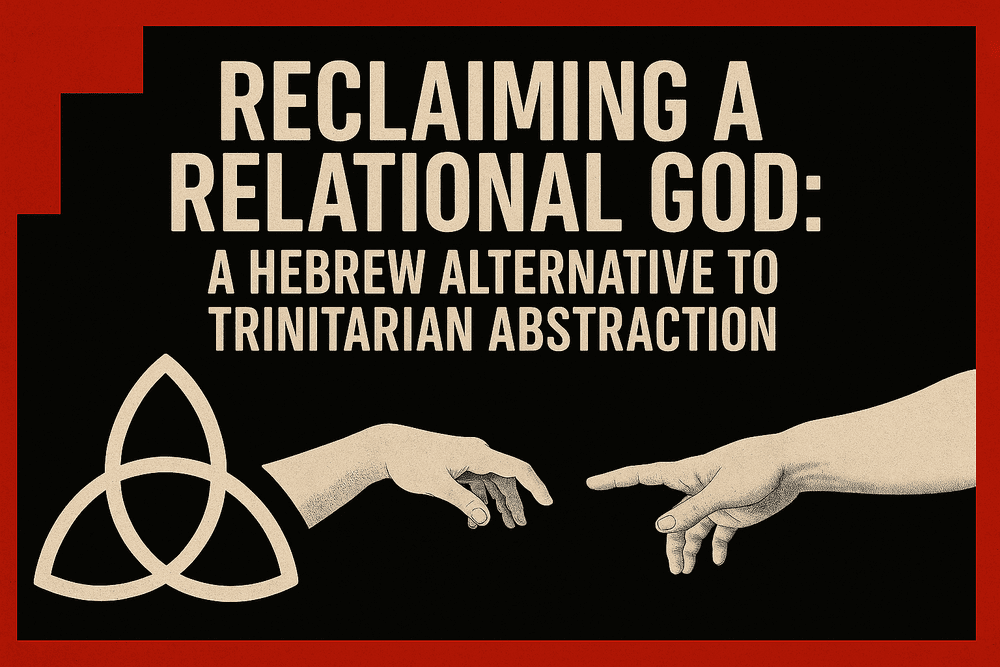Reclaiming a Relational God: A Hebrew Alternative to Trinitarian Abstraction
Modern Christian theology, especially in its creedal and Trinitarian forms, owes much to the philosophical categories of ancient Greece. But when we return to the Bible through a Hebrew lens—as it was understood by the prophets and by Christ Himself—we uncover a framework that resonates strongly with the Latter-day Saint understanding: that two divine beings, Elohim (the Father) and Jehovah (the Son, who became Jesus Christ), operate in perfect unity but are distinct in personhood.
A Tale of Two Worldviews
The contrast between Hebrew (Semitic) and Hellenic (Greek) thought fundamentally shapes how we perceive the divine:
| Feature | Hebrew Thought | Greek Thought |
| God | Personal, covenantal, active in history | Abstract, immutable, beyond comprehension |
| Focus | Relationship, covenant roles | Essence, metaphysical unity |
| Theology | Narrative, functional | Philosophical, ontological |
| View of the Son | Jehovah as divine agent of Elohim, Messiah | Co-equal, co-eternal, same essence as Father |
Divine Plurality in the Hebrew Bible
While mainstream Christianity often assumes that ancient Israel held to a strict monolithic monotheism, the Hebrew scriptures reflect something more complex—and more compatible with the Latter-day Saint model of divine plurality:
1. The Angel of the Lord (Jehovah)
In Genesis 22 and Exodus 3, “the Angel of the Lord” speaks as God, receives worship, and yet is distinct from the one who sends Him.
Latter-day Saints understand this being to be Jehovah—Jesus Christ prior to His earthly birth—acting under the direction of Elohim.
2. Psalm 110:1
“The LORD (Elohim) said unto my Lord (Jehovah), ‘Sit at my right hand…’”
This verse shows a divine conversation between two distinct beings, a passage Jesus Himself cited to illustrate His divine role as Jehovah, subordinate to but exalted by the Father.
3. Daniel 7:13–14
The “Son of Man” comes before the “Ancient of Days” and receives glory and dominion. This matches the Latter-day Saint understanding of Jehovah coming before Elohim, reinforcing divine distinction without abandoning unity of purpose.
These aren’t theological anomalies. They reflect a relational model in which Jehovah, as the Son, carries out the will and work of Elohim, the Father, in perfect harmony.
The Greek Shift: When Theology Went Abstract
As Christianity entered the Greek-speaking world, theologians began interpreting Jesus through philosophical categories like Plato’s unchanging Forms and Aristotle’s metaphysical essence. These abstractions gave rise to the creeds:
- Jesus is “eternally begotten of the Father”
- The Trinity as “three persons in one substance (homoousios)”
While these creeds attempted to preserve divine unity, they obscured the relational clarity of scripture, replacing the tangible roles of Father and Son with mystical metaphysical unity. The God of Abraham, Isaac, and Jacob—who acts, speaks, sends, and covenants—became distant and abstract.
The Latter-day Saint Restoration: Hebrew Clarity Revived
Latter-day Saint theology restores the more concrete, narrative-driven worldview of the Hebrew Bible:
- Elohim (the Father) and Jehovah (the Son) are separate, exalted beings.
- They are united in will, glory, and purpose, not in metaphysical essence.
- Their oneness is relational, as Jesus described in John 17:21, not ontological.
This model aligns not only with Hebrew scripture but with the lived pattern of divine relationships found throughout the Old and New Testaments. Jehovah is the covenant God of Israel, who appears, leads, and delivers on behalf of Elohim. His identity is not a philosophical puzzle but a scriptural reality.
Monotheism Without Metaphysics
The Hebrew understanding of monotheism was not about denying divine complexity—it was about exclusive loyalty to YHWH (Jehovah) as Israel’s God.
In Latter-day Saint belief, Jehovah acts fully on behalf of the Father, never seeking worship independently, but always pointing back to Elohim, His divine source.
Thus, worship of Jehovah as the Son of God does not constitute idolatry. Rather, it fulfills the biblical model of divine agency and unity.
Conclusion: A Relational God Restored
Where Greek philosophy made God abstract, the Hebrew scriptures and Latter-day Saint theology make Him personal, embodied, and deeply relational. The idea of two divine beings—the Father and the Son—acting in perfect unity is not a modern invention. It is a restoration of the ancient, scriptural pattern.
In embracing this relational model, we return to a God who walks with His people, speaks to prophets, sends His Beloved Son, and invites us into the same oneness that unites them.
“That they all may be one; as thou, Father, art in me, and I in thee…” (John 17:21)


